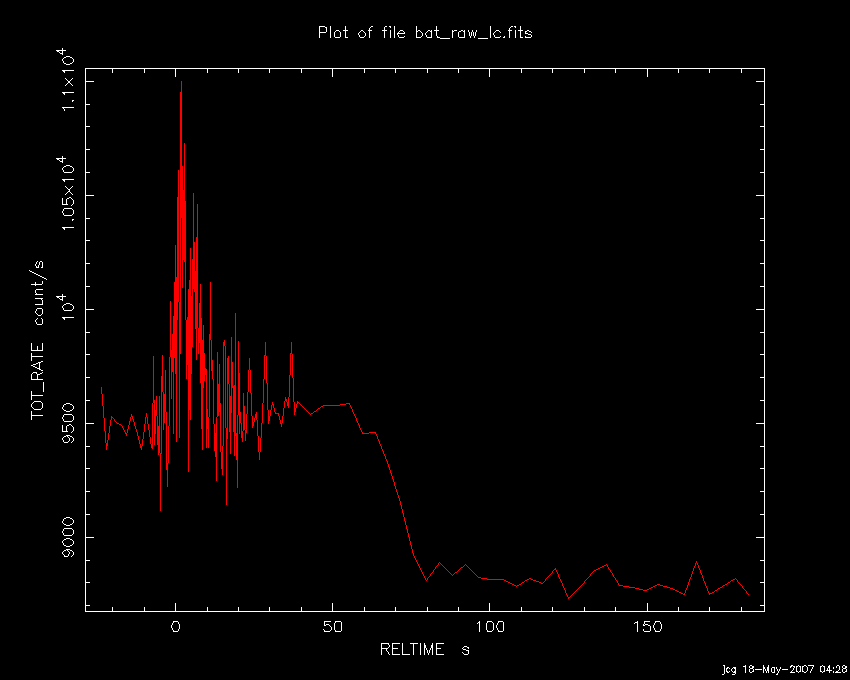(All information courtesy of the instrument teams.)
![]() Previous IAU Circulars
Previous IAU Circulars
TITLE: GCN/SWIFT NOTICE
NOTICE_DATE: Thu 17 May 07 11:21:43 UT
NOTICE_TYPE: Swift-BAT GRB Position
TRIGGER_NUM: 279494, Seg_Num: 0
GRB_RA: 277.579d {+18h 30m 19s} (J2000),
277.751d {+18h 31m 00s} (current),
276.411d {+18h 25m 39s} (1950)
GRB_DEC: -62.333d {-62d 19' 56"} (J2000),
-62.327d {-62d 19' 37"} (current),
-62.367d {-62d 21' 58"} (1950)
GRB_ERROR: 3.00 [arcmin radius, statistical only]
GRB_INTEN: 15607 [cnts] Image_Peak=370 [image_cnts]
TRIGGER_DUR: 3.072 [sec]
TRIGGER_INDEX: 474 E_range: 25-100 keV
BKG_INTEN: 147063 [cnts]
BKG_TIME: 40814.03 SOD {11:20:14.03} UT
BKG_DUR: 32 [sec]
GRB_DATE: 14237 TJD; 137 DOY; 07/05/17
GRB_TIME: 40858.39 SOD {11:20:58.39} UT
GRB_PHI: -100.53 [deg]
GRB_THETA: 22.03 [deg]
SOLN_STATUS: 0x3
RATE_SIGNIF: 11.26 [sigma]
IMAGE_SIGNIF: 8.00 [sigma]
MERIT_PARAMS: +1 +0 +0 +3 +2 +2 +0 +0 +60 +1
SUN_POSTN: 53.87d {+03h 35m 30s} +19.30d {+19d 17' 56"}
SUN_DIST: 127.49 [deg] Sun_angle= 9.1 [hr] (West of Sun)
MOON_POSTN: 62.72d {+04h 10m 52s} +26.11d {+26d 06' 48"}
MOON_DIST: 136.99 [deg]
MOON_ILLUM: 1 [%]
GAL_COORDS: 332.72,-21.46 [deg] galactic lon,lat of the burst (or transient)
ECL_COORDS: 274.52,-39.01 [deg] ecliptic lon,lat of the burst (or transient)
COMMENTS: SWIFT-BAT GRB Coordinates.
COMMENTS: This is a rate trigger.
COMMENTS: A point_source was found.
COMMENTS: This does not match any source in the on-board catalog.
COMMENTS: This does not match any source in the ground catalog.
COMMENTS: This is a GRB.
COMMENTS: This trigger occurred at longitude,latitude = 196.43,-10.42 [deg].

TITLE: GCN/SWIFT NOTICE
NOTICE_DATE: Thu 17 May 07 11:22:49 UT
NOTICE_TYPE: Swift-XRT Nack-Position
TRIGGER_NUM: 279494, Seg_Num: 0
POINT_RA: 277.589d {+18h 30m 21s} (J2000)
POINT_DEC: -62.324d {-62d 19' 24"} (J2000)
IMG_START_DATE: 14237 TJD; 137 DOY; 07/05/17
IMG_START_TIME: 40963.16 SOD {11:22:43.16} UT, 104.8 [sec] since BAT Trigger Time
COUNTS: 27 Min_needed= 20
STD_DEV: 5.40 Max_StdDev_for_Good=28.44 [arcsec]
PH2_ITER: 1 Max_iter_allowed= 4
ERROR_CODE: 3
COMMENTS: SWIFT-XRT Nack Position.
COMMENTS: Standard deviation too large.
TITLE: GCN/SWIFT NOTICE
NOTICE_DATE: Thu 17 May 07 11:24:34 UT
NOTICE_TYPE: Swift-BAT GRB Lightcurve
TRIGGER_NUM: 279494, Seg_Num: 0
GRB_RA: 277.579d {+18h 30m 19s} (J2000),
277.751d {+18h 31m 00s} (current),
276.411d {+18h 25m 39s} (1950)
GRB_DEC: -62.333d {-62d 19' 56"} (J2000),
-62.327d {-62d 19' 37"} (current),
-62.367d {-62d 21' 58"} (1950)
GRB_DATE: 14237 TJD; 137 DOY; 07/05/17
GRB_TIME: 40858.39 SOD {11:20:58.39} UT
TRIGGER_INDEX: 474
GRB_PHI: -100.53 [deg]
GRB_THETA: 22.03 [deg]
DELTA_TIME: 44.00 [sec]
TRIGGER_DUR: 3.072 [sec]
SOLN_STATUS: 0x3
RATE_SIGNIF: 11.26 [sigma]
IMAGE_SIGNIF: 8.00 [sigma]
LC_URL: sw00279494000msb.lc
SUN_POSTN: 53.88d {+03h 35m 30s} +19.30d {+19d 17' 57"}
SUN_DIST: 127.49 [deg] Sun_angle= 9.1 [hr] (West of Sun)
MOON_POSTN: 62.75d {+04h 10m 60s} +26.12d {+26d 07' 09"}
MOON_DIST: 137.01 [deg]
MOON_ILLUM: 1 [%]
GAL_COORDS: 332.72,-21.46 [deg] galactic lon,lat of the burst (or transient)
ECL_COORDS: 274.52,-39.01 [deg] ecliptic lon,lat of the burst (or transient)
COMMENTS: SWIFT-BAT GRB Lightcurve.
COMMENTS:
COMMENTS: The next comments were copied from the BAT_POS Notice:
COMMENTS: This is a rate trigger.
COMMENTS: A point_source was found.
COMMENTS: This does not match any source in the on-board catalog.
COMMENTS: This does not match any source in the ground catalog.
COMMENTS: This is a GRB.
COMMENTS: This trigger occurred at longitude,latitude = 196.43,-10.42 [deg].

TITLE: GCN/SWIFT NOTICE
NOTICE_DATE: Thu 17 May 07 12:22:03 UT
NOTICE_TYPE: Swift-XRT Position
TRIGGER_NUM: 279494, Seg_Num: 0
GRB_RA: 277.6207d {+18h 30m 28.9s} (J2000),
277.7926d {+18h 31m 10.2s} (current),
276.4536d {+18h 25m 48.8s} (1950)
GRB_DEC: -62.2976d {-62d 17' 51.3"} (J2000),
-62.2921d {-62d 17' 31.5"} (current),
-62.3317d {-62d 19' 54.1"} (1950)
GRB_ERROR: 4.7 [arcsec radius, statistical plus systematic, 90% containment]
GRB_INTEN: 6.72e-11 [erg/cm2/sec]
GRB_SIGNIF: 9.80 [sigma]
IMG_START_DATE: 14237 TJD; 137 DOY; 07/05/17
IMG_START_TIME: 40963.16 SOD {11:22:43.16} UT, 104.8 [sec] since BAT Trigger Time
TAM[0-3]: 327.61 237.19 261.35 242.66
AMPLIFIER: 2
WAVEFORM: 134
SUN_POSTN: 53.92d {+03h 35m 40s} +19.31d {+19d 18' 30"}
SUN_DIST: 127.52 [deg] Sun_angle= 9.1 [hr] (West of Sun)
MOON_POSTN: 63.39d {+04h 13m 35s} +26.23d {+26d 13' 56"}
MOON_DIST: 137.35 [deg]
MOON_ILLUM: 1 [%]
GAL_COORDS: 332.76,-21.47 [deg] galactic lon,lat of the burst
ECL_COORDS: 274.55,-38.98 [deg] ecliptic lon,lat of the burst
COMMENTS: SWIFT-XRT Coordinates.
COMMENTS: This Notice was ground-generated -- not flight-generated.
COMMENTS: TAM values are not valid.
RA(J2000) = 18h 30m 19s Dec(J2000) = -62d 19' 56"with an uncertainty of 3 arcmin (radius, 90% containment, including systematic uncertainty). The BAT light curve shows two peaks with a duration of about 10 sec. The peak count rate was ~1000 counts/sec (15-350 keV), at ~1 sec after the trigger.
RA(J2000) = 18h 30m 29.4s Dec(J2000) = -62d 17' 50.8"with an uncertainty of 5.2 arcsec (radius, 90% containment). This position is 2.4 arcmin from the BAT position.
RA(J2000) = 18h 30m 24.7s
Dec(J2000) = -62d 17' 49.8"
with an uncertainty of 1.9 arcmin, (radius, sys+stat, 90% containment).
The partial coding was 67%. The mask-weighted light curve shows a
single peak lasting from approximately T+0 to T+10 seconds.
T90 (15-350 keV) is 9.0 +- 1 sec (estimated error including systematics).
RA/Dec(J2000) = 18h 30m 29.0s -62d 17' 51.7" which is RA/Dec(J2000) = 277.6207 -62.2977with an uncertainty of 3.7 arcsec (radius, 90% containment). This position lies 3.5 arcsec from the XRT position and 2.4 arcmin from the BAT position given in GCN Circ. 6411 (Vergani et al.).